1995 GMC SIERRA light
[x] Cancel search: lightPage 304 of 488
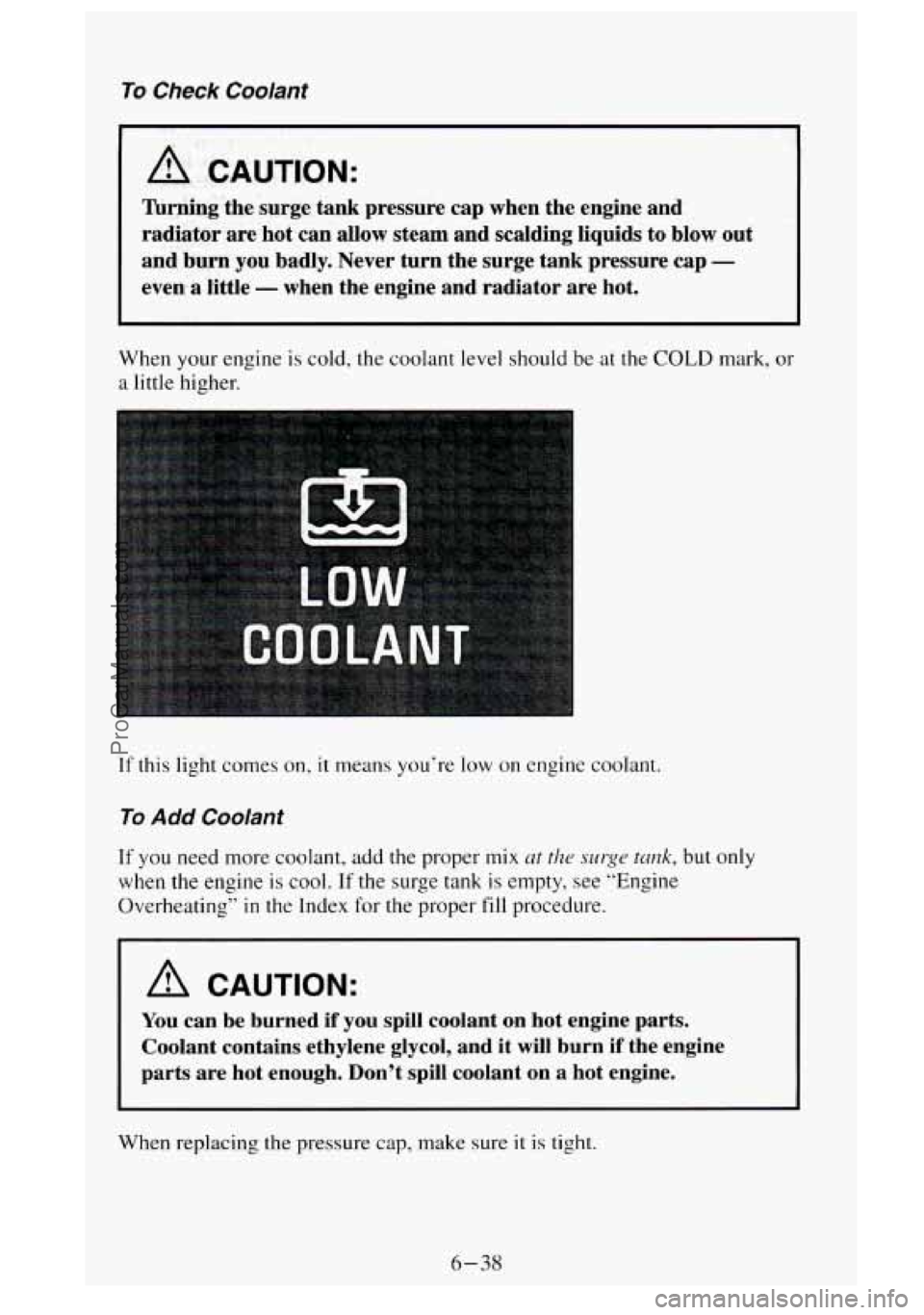
To Check Coolant
A CAUTION:
Turning the surge tank pressure cap when the engine and
radiator are hot can allow steam and scalding liquids to blow out
and burn you badly. Never turn the surge tank pressure cap
-
even a little - when the engine and radiator are hot.
When your engine is cold, the coolant level should be at the COLD mark, or
a little higher.
If this light comes on, it means you’re low on engine coolant.
To Add Coolant
If you need more coolant, add the proper mix ut the surge tmk, but only
when the engine is cool. If the surge tank is empty, see “Engine
Overheating”
in the Index for the proper fill procedure.
A CAUTION:
You can be burned if you spill coolant on hot engine parts.
Coolant contains ethylene glycol, and
it will burn if the engine
parts are hot enough. Don’t spill coolant on a hot engine.
When replacing the pressure cap, make sure it is tight.
6-38
ProCarManuals.com
Page 310 of 488

Brake Wear
Your vehicle has front disc brakes and rear drum brakes. If you have a C
3500 HD model, it has four-wheel disc brakes.
Disc brake pads have built-in wear indicators that make
a high-pitched
warning sound when the brake pads are worn and new pads are needed. The
sound may come and
go or be heard all the time your vehicle is moving
(except when you are pushing on the brake pedal firmly).
I A CAUTION:
The brake wear warning sound means that sooner or later your
brakes won’t work well. That could lead to an accident. Whe\
n
you hear the brake wear warning sound, have your vehicle
serviced.
NOTICE:
Continuing to drive with worn-out brake pads could result in
costly brake repair.
Some driving conditions or climates may cause a brake squeal when the
brakes are first applied or lightly applied. This does not mean something is
wrong with your brakes.
If you have rear drum brakes, they don’t have wear indicators, but if you
ever hear
a rear brake rubbing noise, have the rear brake linings inspected.
Also, the rear brake drum should be removed and inspected each time the
tires are removed for rotation
or changing. When you have the front brakes
replaced, have the rear brakes inspected, too.
Brake linings should always be replaced as complete axle sets.
Brake Pedal Travel
See your dealer if the brake pedal does not return to normal height, or if
there is a rapid increase in pedal travel. This could be a sign of brake
trouble.
6-44
ProCarManuals.com
Page 323 of 488

Three- Way Catalytic Converter (Gasoline Engines)
Your vehicle’s three-way catalytic converter is designed to reduce the
pollutants
in your vehicle‘s exhaust. Use only unleaded fuel in your vehicle.
If you use leaded fuel, you could damage your three-way catalytic converter
and other engine components.
Oxidation Catalytic Converter (Diesel Engines)
Your vehicle’s oxidation catalytic converter is designed to reduce the
particulates
in your vehicle‘s exhaust. If your vehicle’s oxidation catalytic
converter ever needs to be replaced,
it must be replaced with an oxidation
converter intended for use
with diesel engines only.
Engine Control Module System
Gasoline Engines
This system has an oxygen sensor (OS) that helps keep your engine’s
air-fuel mixture at a proper level. Use only unleaded fuel in your vehicle. If
you use leaded fuel, you could damage your oxygen sensor
(OS) and
three-way catalytic converter.
Diesel Vehicles Below 8,500 (3 850 Kg) G VWR
This system monitors engine speed and throttle position. It adjusts exhaust
gas recirculation to limit emissions.
Malfunction Indicator (SERVICE ENGINE SOON)
Light
The Malfunction Indicator (SERVICE ENGINE SOON) Light on your
instrument panel lets you know when your emission system needs service.
The light will come on briefly when you start your engine to
let you know
that the system is working. If
it does not come on when you start your
engine, or
if it comes on and stays on while you’re driving, your system
may need service. Your vehicle should still be driveable, but you should
have your system serviced right away.
Secondary Air Injection Reaction (AIR) System
(Gasoline Engines)
You may have this system. It has a control valve that will direct air to where
it is needed. If the AIR system needs service, your Malfunction Indicator
(SERVICE ENGINE
SOON) Lamp on your instrument panel will come on.
6-57
ProCarManuals.com
Page 334 of 488
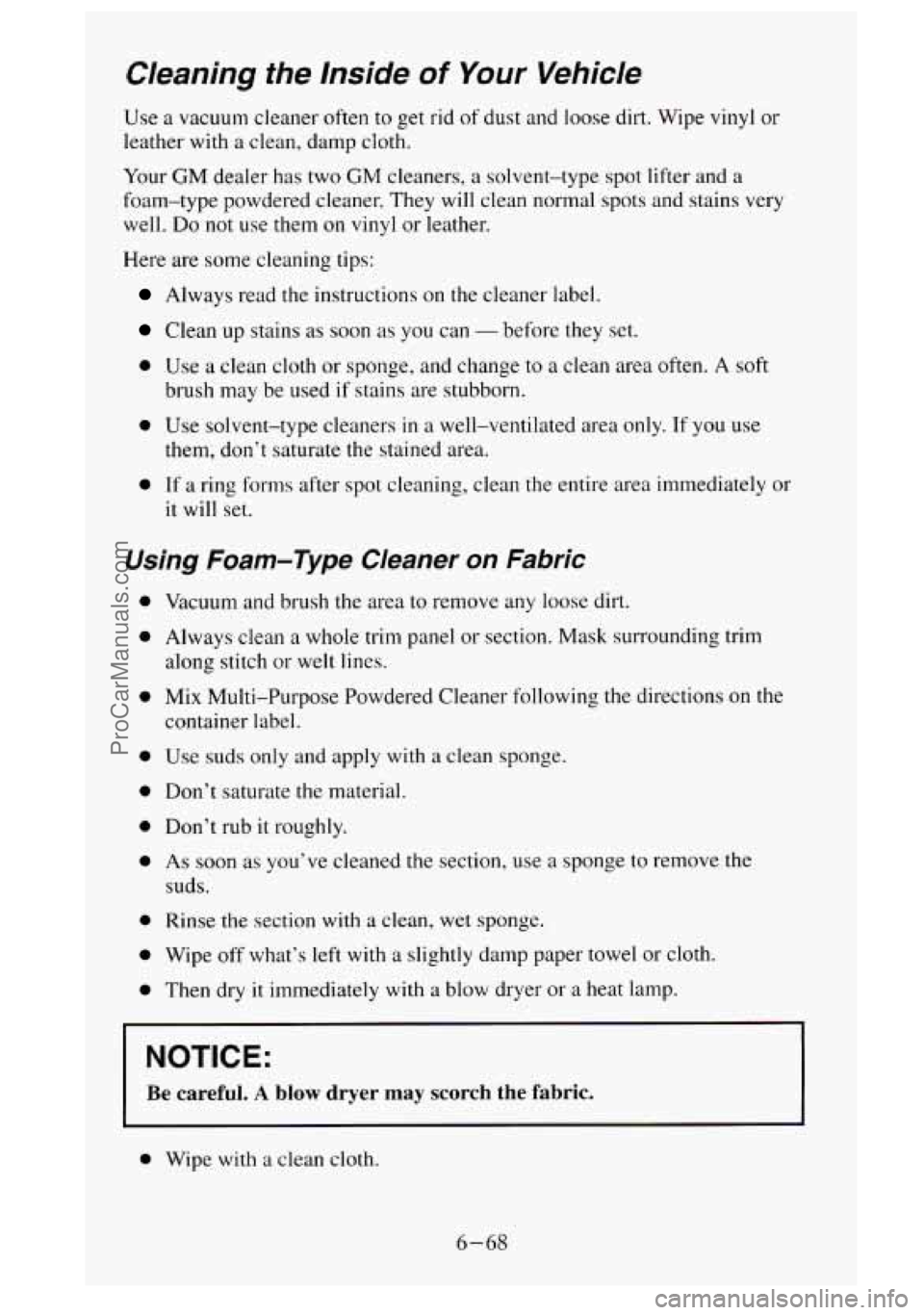
0
e
0
0
0
0
C/eaning the Inside of Your Vehicle
Use a vacuum cleaner often to get rid of dust and loose dirt. Wipe vinyl or
leather with a clean, damp cloth.
Your
GM dealer has two CM cleaners, a solvent-type spot lifter and a
foam-type powdered cleaner. They will clean normal spots and stains very
well. Do
not use them on vinyl or leather.
Here are some cleaning tips:
Always read the instructions on the cleaner label.
Clean up stains as soon as you can - before they set.
0 Use a clean cloth or sponge, and change to a clean area often. A soft
brush may be used
if stains are stubborn.
0 Use solvent-type cleaners in a well-ventilated area only. If you use
them, don‘t saturate the stained area.
0 If a ring forms after spot cleaning, clean the entire area immediately or
it will set.
Using Foam-Type Cleaner on Fabric
Vacuum and brush the area to remove any loose dirt.
Always clean
a whole trim panel or section. Mask surrounding trim
along stitch or welt lines.
Mix Multi-Purpose Powdered Cleaner following the directions on the
container label.
Use suds
only and apply with a clean sponge.
Don’t saturate the material.
Don’t
rub it roughly.
As soon as you’ve cleaned the section, use a sponge to remove the
suds.
Rinse the
section with a clean, wet sponge.
Wipe
off what’s left with a slightly damp paper towel or cloth.
Then dry
it immediately with a blow dryer or a heat lamp.
NOTICE:
Be careful. A blow dryer may scorch the fabric.
~~ ~
0 Wipe with a clean cloth.
6-68
ProCarManuals.com
Page 335 of 488
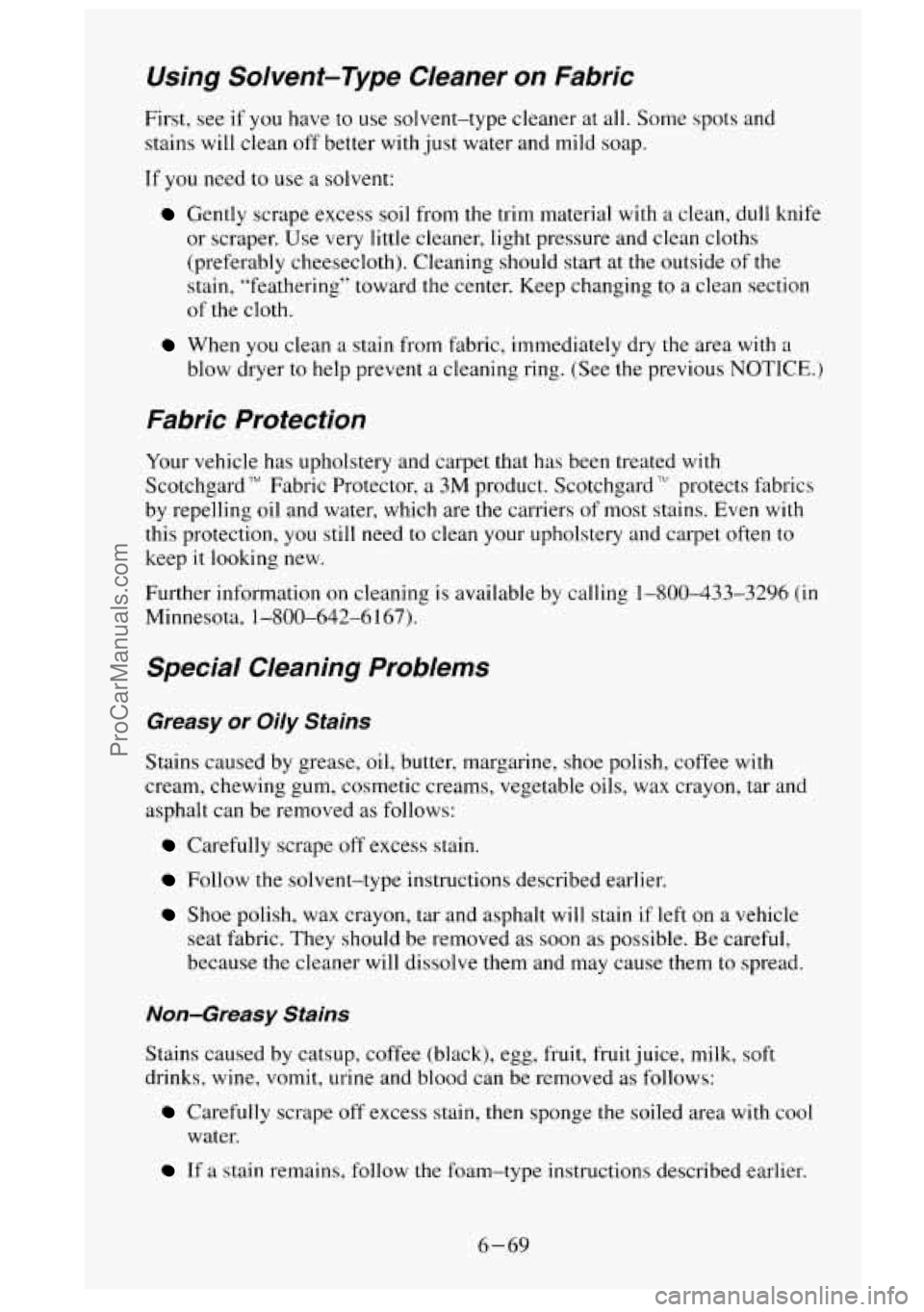
Using Solvent-Type Cleaner on Fabric
First, see if you have to use solvent-type cleaner at all. Some spots and
stains will clean
off better with just water and mild soap.
If you need to use a solvent:
Gently scrape excess soil from the trim material with a clean, dull knife
or scraper. Use very little cleaner, light pressure and clean cloths
(preferably cheesecloth). Cleaning should start at the outside of the
stain, “feathering” toward the center. Keep changing to
a clean section
of the cloth.
When you clean a stain from fabric, immediately dry the area with a
blow dryer to help prevent a cleaning ring. (See the previous NOTICE.)
Fabric Protection
Your vehicle has upholstery and carpet that has been treated with
Scotchgard TM Fabric Protector, a 3M product. Scotchgard TN protects fabrics
by repelling oil and water, which are the carriers of most stains. Even with
this protection, you still need to clean your upholstery and carpet often to
keep
it looking new.
Further information
on cleaning is available by calling 1-800-433-3296 (in
Minnesota, 1-800-642-6 167).
Special Cleaning Problems
Greasy or Oily Stains
Stains caused by grease, oil, butter, margarine, shoe polish, coffee with
cream, chewing gum, cosmetic creams, vegetable oils, wax crayon, tar and
asphalt can be removed as follows:
Carefully scrape off excess stain.
Follow the solvent-type instructions described earlier.
Shoe polish, wax crayon, tar and asphalt will stain if left on a vehicle
seat fabric. They should be removed as soon
as possible. Be careful,
because the cleaner will dissolve them and may cause them to spread.
Non-Greasy Stains
Stains caused by catsup, coffee (black), egg, fruit, fruit juice, milk, soft
drinks, wine, vomit, urine and blood can be removed as follows:
Carefully scrape off excess stain, then sponge the soiled area with cool
water.
If a stain remains. follow the foam-type instructions described earlier.
6-69
ProCarManuals.com
Page 336 of 488
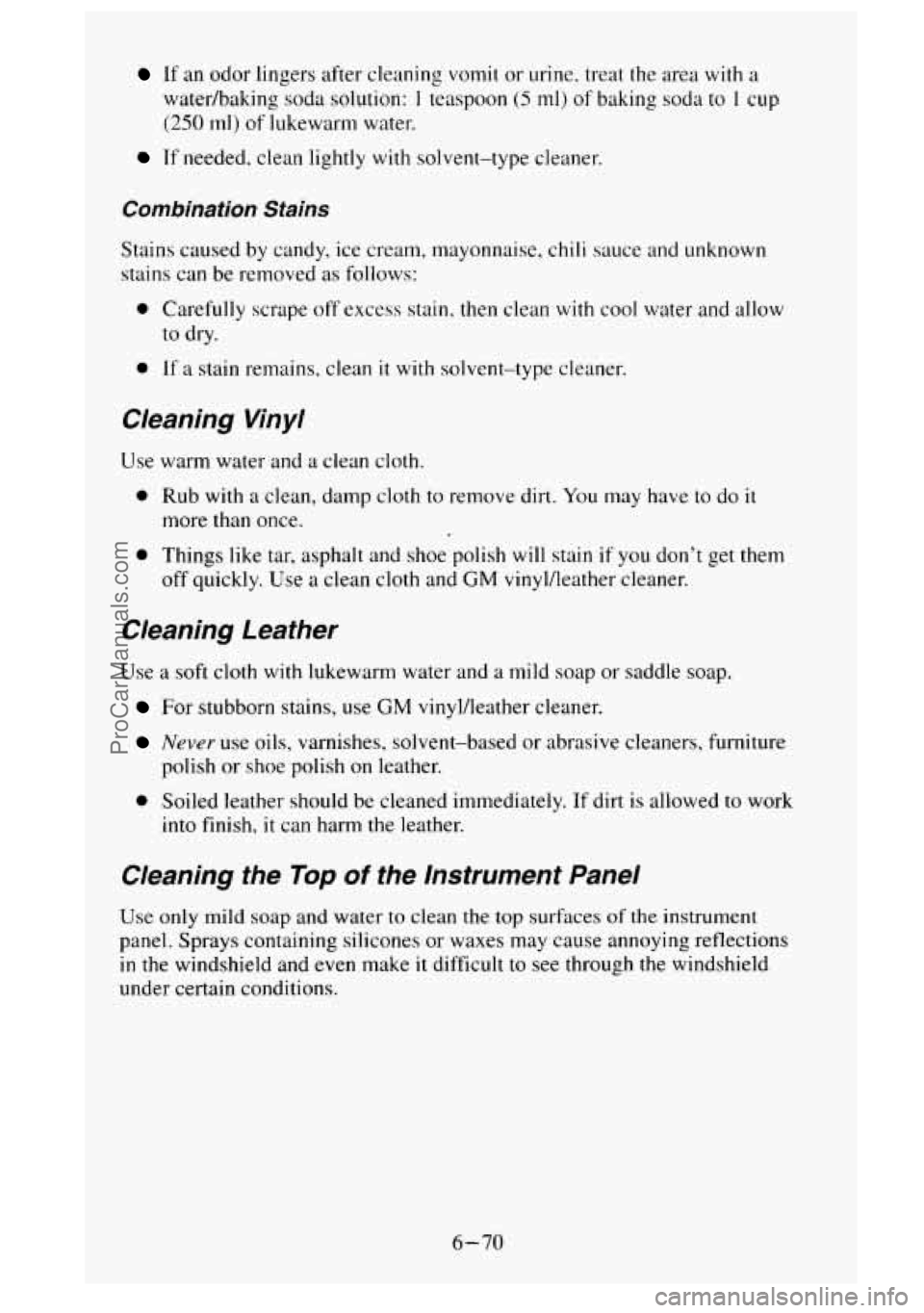
If an odor lingers after cleaning vomit or urine, treat the area with a
waterhaking soda solution:
I teaspoon (5 ml> of baking soda to 1 cup
(250 ml) of lukewarm water.
If needed, clean lightly with solvent-type cleaner.
Combination Stains
Stains caused by candy, ice cream, mayonnaise, chili sauce and unknown
stains can be removed as follows:
0 Carefully scrape off excess stain, then clean with cool water and allow
to dry.
0 If a stain remains, clean it with solvent-type cleaner.
Cleaning Vinyl
Use warm water and a clean cloth.
0 Rub with a clean, damp cloth to remove dirt. You may have to do it
more than once.
0 Things like tar, asphalt and shoe polish will stain if you don’t get them
off quickly. Use
a clean cloth and GM vinyMeather cleaner.
Cleaning Leather
Use a soft cloth with lukewarm water and a mild soap or saddle soap.
For stubborn stains, use GM vinylheather cleaner.
Never use oils, varnishes, solvent-based or abrasive cleaners, furniture
polish or shoe polish on leather.
0 Soiled leather should be cleaned immediately. If dirt is allowed to work
into finish,
it can harm the leather.
Cleaning the Top of the Instrument Panel
Use only mild soap and water to clean the top surfaces of the instrument
panel. Sprays containing silicones
or waxes may cause annoying reflections
in the windshield and even make it difficult to see through the windshield
under certain conditions.
6-70
ProCarManuals.com
Page 346 of 488
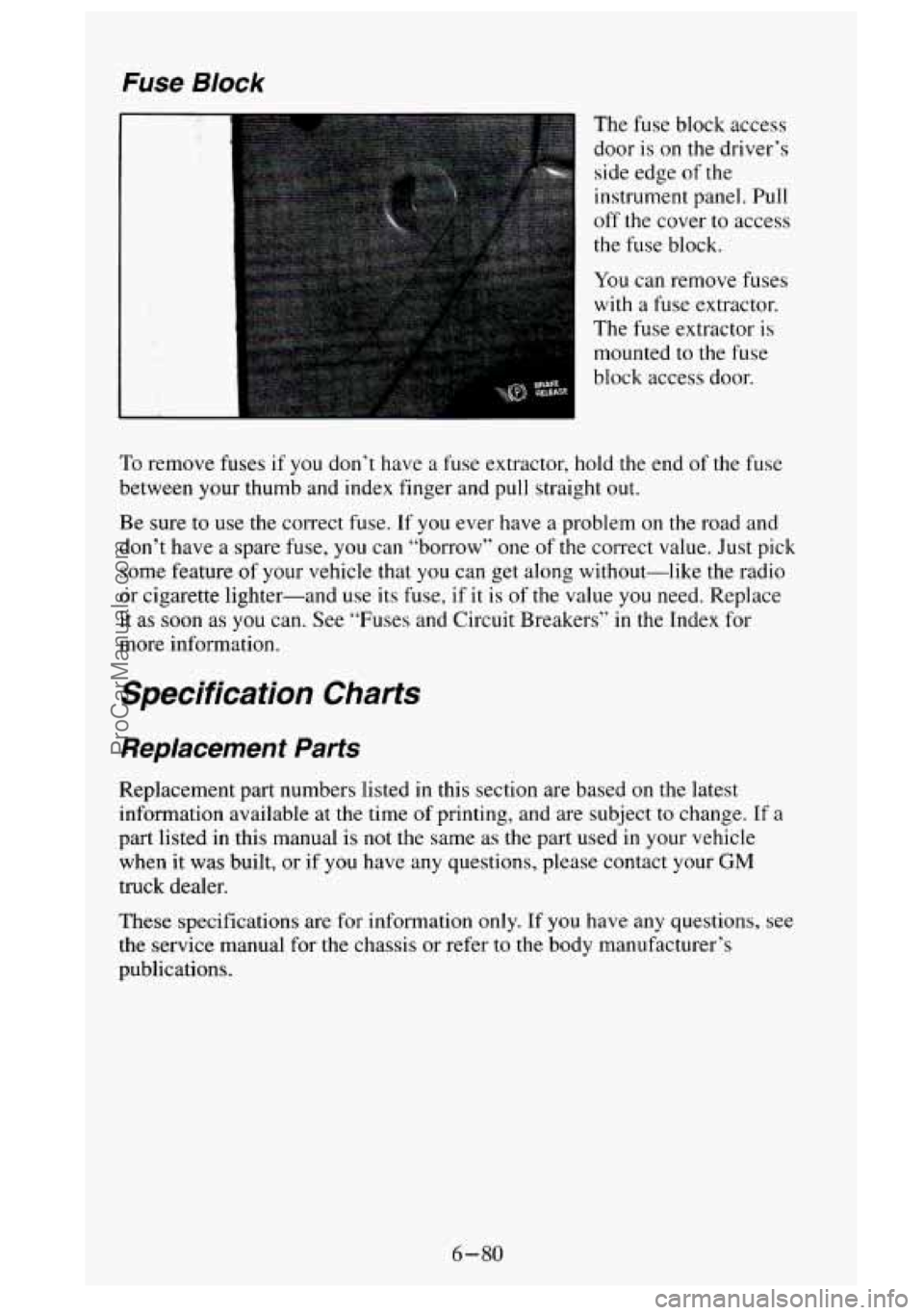
Fuse Block
The fuse block access
door is on the driver’s
side edge
of the
instrument panel.
Pull
off the cover to access
the fuse block.
You can remove fuses
with a fuse extractor.
The fuse extractor is
mounted to the fuse
block access door.
To remove fuses if you don’t have a fuse extractor, hold the end of the fuse
between your thumb and index finger and pull straight out.
Be sure to use the correct fuse. If you ever have a problem
on the road and
don’t have a spare fuse, you can “borrow” one
of the correct value. Just pick
some feature of your vehicle that
you can get along without-like the radio
or cigarette lighter-and use its fuse, if
it is of the value you need. Replace
it as soon as you can. See “Fuses and Circuit Breakers” in the Tndex for
more information.
Specification Charts
Replacement Parts
Replacement part numbers listed in this section are based on the latest
information available at the time
of printing, and are subject to change. If a
part listed in this manual is not the same as the part used in your vehicle
when it was built,
or if you have any questions, please contact your GM
truck dealer.
These specifications are for information
only. If you have any questions, see
the service manual for the chassis or refer
to the body manufacturer’s
publications.
6-80
ProCarManuals.com
Page 347 of 488
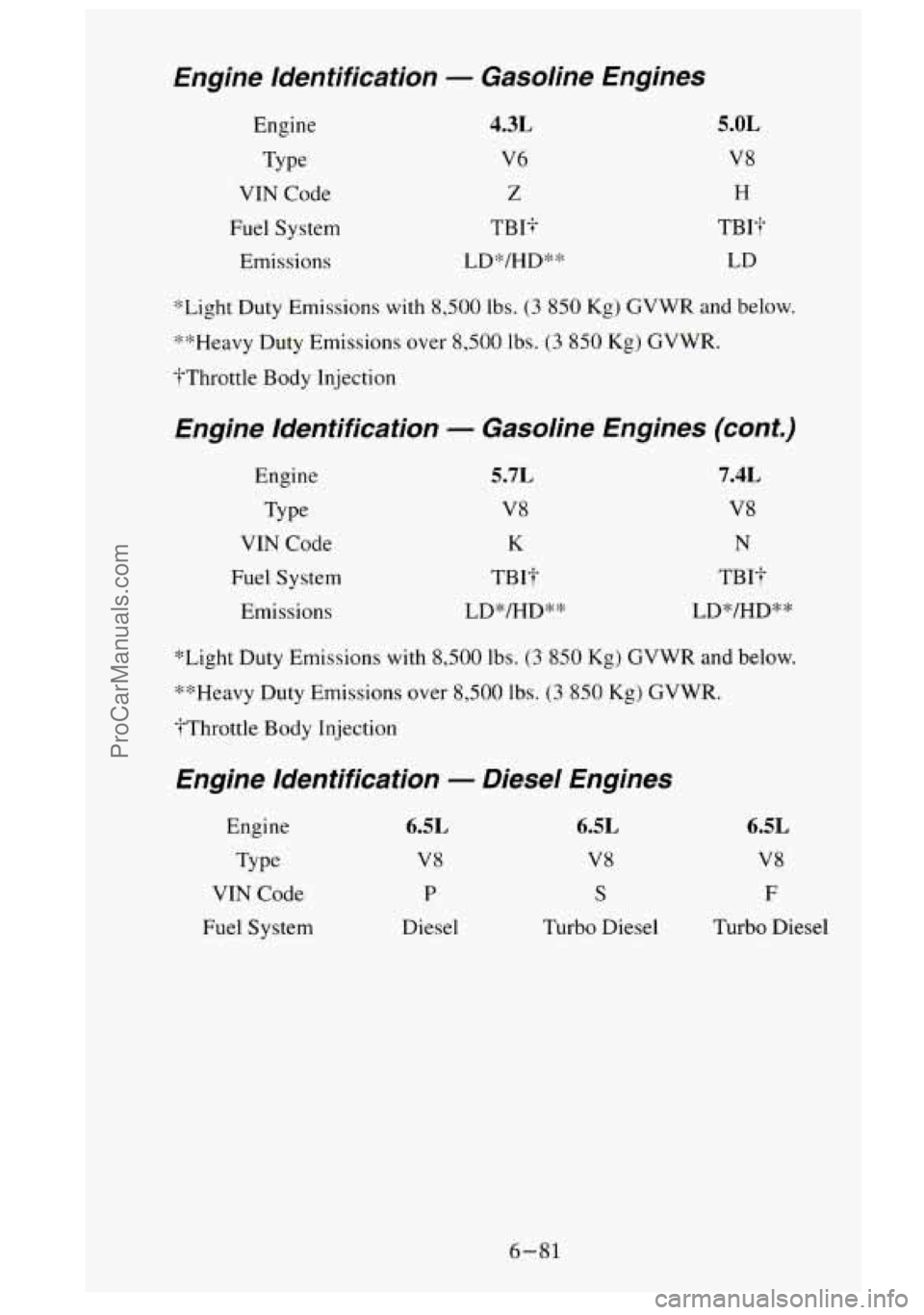
Engine Identification - Gasoline Engines
Engine
Type
VIN Code
Fuel System
Emissions
5.0L
V8
H
TBI? LD
"Light Duty Emissions with
8,500 lbs. (3 850 Kg) GVWR and below.
**Heavy Duty Emissions over 8,500 lbs. (3 850 Kg) GVWR.
?Throttle Body Injection
Engine Identification - Gasoline Engines (cont.)
Engine
Type
VIN Code
Fuel System
Emissions 7.4L
V8
N
TBI?
LD*/HD**
"Light Duty Emissions with 8,500 lbs. (3 850 Kg) GVWR and below.
""Heavy Duty Emissions over
8,500 lbs. (3 850 Kg) GVWR.
?Throttle Body Injection
Engine Identification - Diesel Engines
Engine
Type
VIN Code
Fuel System
6.5L
V8
P
Diesel
6.5L
V8 S
Turbo Diesel
6.5L
V8
F
Turbo Diesel
6-81
ProCarManuals.com